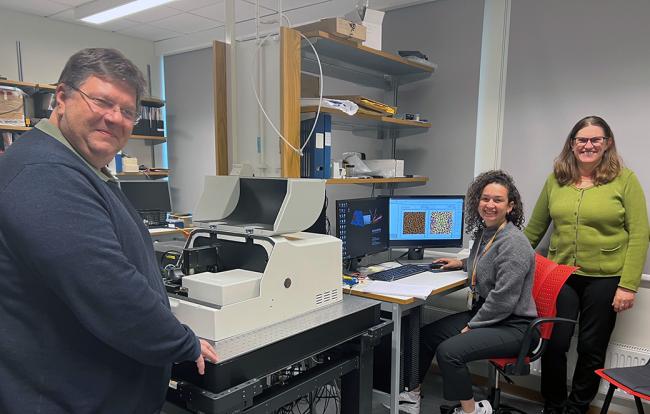Solar cell researchers in international collaboration
2025-05-22International mobility enables valuable collaboration for researchers from Karlstad University and UMONS, the University of Mons in Belgium. The collaboration promotes research in materials science through exchange of knowledge on methods for studying material properties at the nanoscale.
– My visit here at Karlstad University has been enriching in many ways, says Philippe Leclere from UMONS. Since we work in the same field of research, that is, materials for organic solar cells, it is very interesting to exchange experiences. We study the material’s properties at the molecular level and how the molecules in the active layer organise themselves. This includes the material’s mechanical, chemical and electrical properties, which we study using scanning probe microscopy. What we contribute from our respective universities is highly valuable for all parties involved.
Organic solar cells are a promising technology, thanks to advantages such as low weight, flexibility and a wide range of applications. The light-absorbing layer consists of a thin film, about one-hundredth the thickness of a strand of hair, that absorbs light and converts it into electricity. This layer uses a combination of molecules that can donate and accept electrons. For materials researchers, it is important to distinguish between these molecules and to map their distribution with nanometer resolution.
– We are very pleased to have Philippe Leclere here for just over a week, and that he was also able to give a lecture for our students, doctoral students and other staff, says Ellen Moons, professor of physics. I recently made a similar visit to the University of Mons, where I had the opportunity to learn about their research on nanomaterials and was very impressed by the equipment they have. Our research focuses on increasing the efficiency and lifetime of organic solar cells through a deeper understanding of the material. Our international collaboration contributes significantly to this research, not least by providing our doctoral students with access to advanced research equipment.
Philippe’s and Ellen’s exchange was made possible through funding from FNRS, the Belgian Fund for Scientific Research. Leticia Christopholi received a research scholarship from the Royal Swedish Academy of Sciences to spend a month at UMONS.
Students are also able to visit other universities through EUNICE
– I’ve had the privilege to visit the University of Mons, says Letitcia Christopholi, doctoral student in Physics. I used their Scanning Probe Microscopes to study the organisation and electrical properties of molecules and how they change under illumination. I also participated in a joint workshop together with researchers from Brazil. I will return to Mons this spring, and it’s truly an opportunity I deeply appreciate. It’s so enriching, not only for my doctoral studies but also culturally, to meet researchers from other countries and continents.
– We will continue to deepen our collaboration with the University of Mons, says Ellen Moons. Their physics department has truly cutting-edge equipment, which is a great benefit for us to have access to through this collaboration. Next, we are planning a return visit this autumn and to co-author an article together.
Karlstad University and UMONS are both part of Eunice, the European University for Customised Education, a European university alliance, together with eight other European universities. The aim is to inspire and facilitate collaboration between the universities, across various educational and research fields, and with the wider community.


